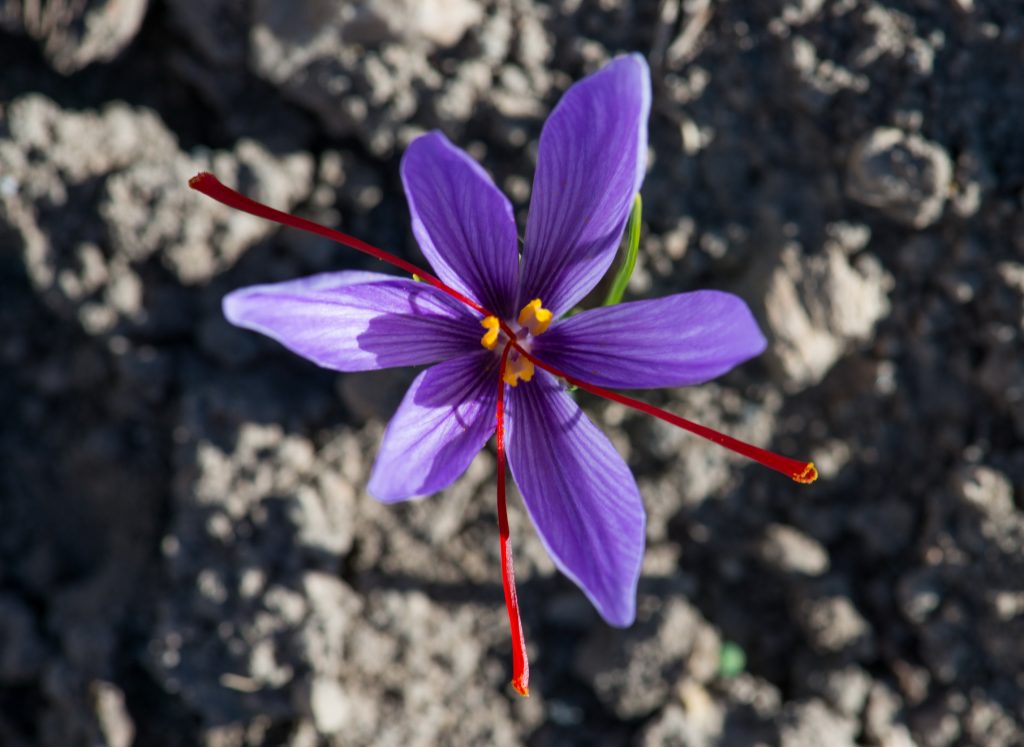Add saffron to meals enhances the aroma and brings benefits to our health. These benefits can be found in the Aldonza guide, but in this article, we take a step further. We travel to the past. In Middle Ages, saffron was already used as a medicine. This spice, cultivated mostly in Castilla La Mancha (Spain), stimulates our brain and becomes an excellent medicine against depression and Alzheimer.
La Mancha, land of saffron
The land is very important in the cultivation of saffron. The most widespread version of the etymological meaning of La Mancha is ‘Land without water’. This is the name that the Arabs gave to the community that includes part of the provinces of Albacete, Ciudad Real, Cuenca and Toledo. A territory plagued by low and arid landscapes that are accentuated in their harshness with the arrival of autumn.
Fortunately, September grants the inhabitants of this part of the Peninsula a small city with a show that has the color purple to its main protagonist: fields plagued with saffron flowers. Saffron Aldonza is grown in one of the most privileged areas of La Mancha. Northwest of Albacete, in the ‘Dehesas de Navamarín’, Aldonza saffron flourishes between a millennial juniper. This saffron has La Mancha Protected Denomination of Origin.
Saffron, a medicine with history
We return to the Middle Ages. At that time, saffron is used as a cure against melancholy or as a stimulant to facilitate activities such as singing. It is not strange, therefore, that the scientific community has been interested in the effects that this spice causes in moods.
Pat Willard, author of ‘Secrets of Saffron’, says that saffron has a long history as medicine in Europe. In his book, he also mentioned that it was used mainly against melancholy. The stigmas were mixed with molasses and the saffron was taken in small pills. It is equivalent to a dose of Prozac.
Gonzalo De Diego Lamos wrote in the newspaper ‘El Confidencial‘ that more than 20 years ago, the musicologist specializing in medieval studies at Arizona State University, Volker Schier, discovered a collection of letters by Katarina Lemmel, a 15th century business woman. She negotiated with saffron.
At some point in his life, Lemmel decided to leave his job to become a nun in the German region of Bavaria. In his new job, Lemmel requested large quantities of saffron per year. In the current market, such proportions of the La Mancha saffron, could cost close to 10.000 euros. Lemmel argued that saffron helped the nuns to sing longer and with more intensity.
Anti-depressant properties of saffron
Sure you are answering a question: why does saffron cause changes in our brain? Mainly, it is for three compounds: crocin, crocetin and safranal.
We can also read in Lamos text in ‘The Confidential’ that Adrian Lopresti, clinical psychologist and researcher at Murdoch University in Australia, collected all the information published in 12 studies that analyze the antidepressant properties of the spice. The expert too said that the saffron doesn’t cause side effects. One recommendation: do not take more than five grams. Although it is not yet known exactly how saffron acts on our brain, Lopresti says it feels “safe enough to recommend them as an antidepressant”.
Saffron, against Alzheimer’s
The second line of research examines the effects of saffron on the nervous system for the detection of Alzheimer’s disease. In a study, the results of the intake of 15 milligrams of extract of the stigmas were evaluated, observing the improvement in the cognitive functions of the patients who took the dose, in comparison with the only a placebo.
To conclude, Aldonza recommends you the book ‘Recipes for the memory’. This is a Spanish work that rescues the memory of Alzheimer’s disease through an act of instinctive and endearing cooking and the use of saffron.





